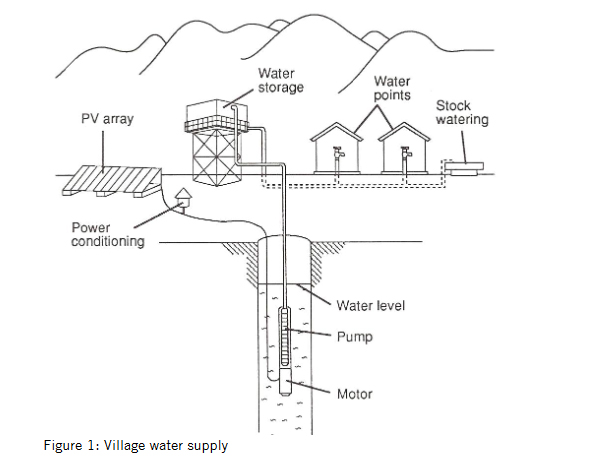Basics
Solar water pumping system has a long history, so many methods have been developed to pump water. People have used a variety of power sources, namely human energy, animal power, hydro power, wind, solar and fuels such a diesel for small generators. The most common pumps used in remote communities are:
- Hand pumps.
- Direct drive diesel driven borehole pumps.
- Electric submersible pumps with diesel generator.
- Solar well pumps.
The relative merits of the various pumping methods are laid out in Table 1 below.
| Advantages | Disadvantages | |
| Hand pumps Link | • local manufacture is possible • easy to maintain • low capital cost • no fuel costs | • loss of human productivity • often an inefficient use of boreholes • low flow rates |
| Animal driven pumps | • more powerful than humans • lower wages than human power • dung may be used for cooking fuel | • animals require feeding all year round • often diverted to other activities at crucial irrigation periods |
| Hydraulic pumps (e.g. rams) Link | • unattended operation • no fuel costs • easy to maintain • low cost • long life • high reliability | • require specific site conditions • low output |
| Wind pumps Links | • unattended operation • no fuel costs • easy to maintain • low cost • long life • high reliability | • water storage is required for low wind periods • high system design and project planning needs • not easy to install |
| Solar PV | • unattended operation • easy maintenance • long life • suited to local manufacture • no fuel requirements | • high capital costs • water storage is required for cloudy periods • repairs often require skilled technicians |
| Diesel and gasoline pumps | • quick and easy to install • low capital costs • widely used • can be portable | • fuel supplies erratic and expensive • high maintenance costs • short life expectancy • noise and fume pollution |
Application
Solar water pumps are used principally for three applications:
- Village water supply.
- Livestock watering.
- Irrigation.
A solar water pump for the village water supply is shown schematically in Figure 1. The Village will have a constant water demand although there is need to store water for periods of low insolation (low solar radiation). In environments where rainy seasons occur some of this demand can be met by rainwater harvesting during the rainy season.
Ideally in Sahelian Africa, the storage would be 3-5 days of water demand. In practice, some installed tanks do not have sufficient capacity and are smaller than a days demand leaving the tank empty at the end of the day. This is due to a mismatch between the sizing, solar water pump capacity and the demand profile during the day.

The main applications for solar water pumping are for livestock watering in the USA and Australia. In Africa the systems are used for village water systems and livestock watering. While applications of solar water pumping for irrigation are on the increase especially in India and China.
A solar irrigation system (Figure 2) needs to take account of the fact that demand for irrigation water will vary throughout the year. Peak demand during the irrigation seasons is often more than twice the average demand. This means that solar pumps for irrigation can be under-utilised for most of the year although there can be a reduction in strength of the sun during these times reducing supply side of the equation.
Attention should be paid to the system of water distribution and application to the crops. The system should minimise water losses, without imposing significant additional head on the pumping system and be of low cost.
